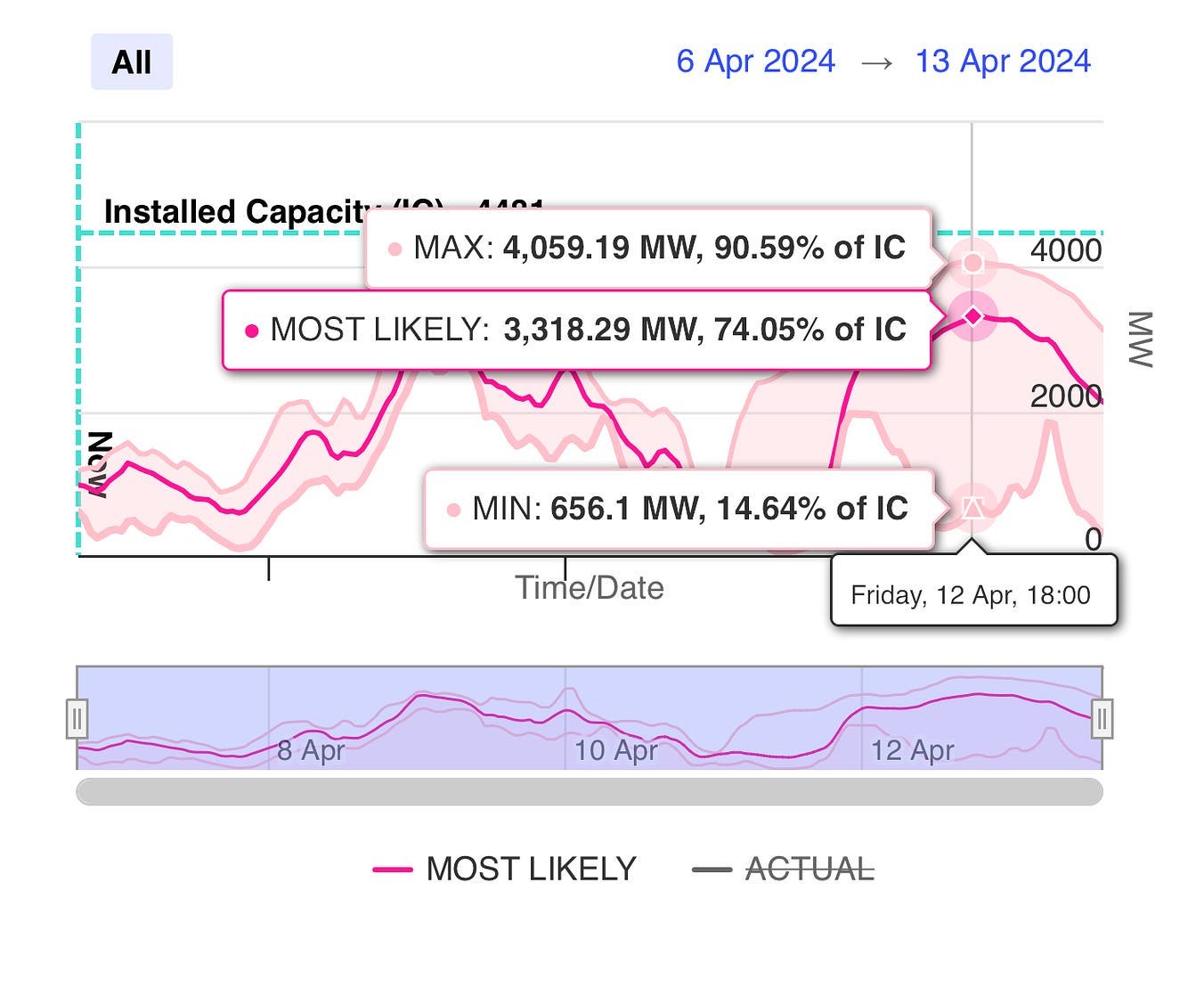Injecting Chaos
Here's how to forecast wind power output: it'll be somewhere between all or nothing, sometime next week - probably.
Imagine this chaotic scenario. You’re a wedding planner. It’s Saturday and you’re preparing for a wedding this upcoming Friday at 6PM. When you ask how many guests will attend, the bride and groom say they expect somewhere between 656 and 4059 guests. The best guess estimate is that about 3318 of the bride’s and groom’s closest friends and relatives will attend. But regardless of how many show up, you have to make sure there are enough white folding chairs set up for their perfect outdoor wedding. But there can’t be any empty chairs - that’ll look bad in the pictures.
And we’ll add a wrinkle to the plot - you don’t actually own any folding chairs and no one shop in town has that many chairs. So, you’ll have to coordinate multiple rentals to have enough available chairs to cover that range of uncertainty. But no sweat, it’s only a 3403-chair difference between the low end guess and the high end guess.
You might chuckle at what seems like a bit of a silly scenario. And most reasonable people would probably agree that planning for that amount of uncertainty is just a tad bit ridiculous.
But it’s real life for a grid operator trying to plan a grid with large amounts of wind capacity. It’s an often overlooked, but major risk: adding wind power to a grid increases the risk of forecast failures because wind output is very difficult to estimate ahead of time. This increases the risk of planning failures which can lead to more blackouts and brownouts.
The Wild Range Of Real-Life Forecasts For Wind Output
Alberta’s grid operator (AESO)’s job is to coordinate Alberta’s grid. But the grid operator doesn’t own any of the power plants. It goes back to a time when monopoly smashing was considered fashionable. The idea was if we break up utility monopolies, then it’ll encourage competition. While that sounded good on paper, it makes coordinating a grid that much more complex.
Nevertheless, AESO is supposed to coordinate enough power plants to meet demand (which on average is around 10,000MW of electricity.) A large part of Alberta’s grid is made up of ~ 4481MW of installed wind capacity. To accommodate that wind, AESO forecasts wind output to coordinate enough power-plants to be on-line (or in reserve) to cover expected demand.
To illustrate, on April 6th, 2024, AESO forecasted potential wind output for the next week.
In that forecast, there was a massive amount of uncertainty. At that time, the “MOST LIKELY” output for wind on April 12 at 6pm was estimated to be 3318MW (75% of installed capacity). But, the forecast ranged somewhere between…656 and 4059MWs, meaning the grid operator expected wind to perform between 14.64% to 90.59% of its installed capacity.
Or in plain English: wind output is pretty much expected to be somewhere between all or nothing, sometime next week - probably.
But as the week progressed, the forecast changed significantly.
Let’s move forward to April 8th to see what AESO thought wind output might look like on April 12th at 6pm. The updated forecast called for only 1611MWs of wind as “most likely,” ranging between ~1183 and 2798MWs.
But in 2 days, not only did the projected output radically change, the peak estimated time changed as well. Initially, the forecast called for wind output to peak around 5-7pm at 75% of capacity. This could help offset any decline from solar later in the day. But the updated forecast now predicted that wind would peak at 1pm at approx 2663 MW or (60% of installed capacity). This updated forecast has wind declining around the same time that the sun will go down. Meaning, this forecast now predicted that wind’s decline would increase - not reduce - the amount of fossil fuel plants needed to ramp up that evening.
Back to the wedding planning analogy…
…The good news is that the range of guests tightened up, but it’s way off from the original best guess. And now, the wedding time has changed from 6pm (peak) to 1pm (peak).
As most readers know, a grid generates its electricity in real time, regardless of if that electricity is coming from a wind turbine, a gas plant, or a battery. In the wedding planning analogy, you need seats for every guest, when the guest is there, but you can’t have empty seats. (Yes you might have seats waiting on the sidelines to bring online quickly but you can’t have empty seats ‘generating’ electricity because there’s no one on the other end to use it in real time).
Why Is Wind Output So Difficult To Forecast?
If wind was just intermittent (up and down) and predictable like an ocean tide, it would be a lot easier to plan a grid around it. But wind output is the opposite of predictable and dependable -it’s chaotic, erratic, and difficult to predict because:
Weather is difficult to predict
Wind speed acts as a lever and has an outsized impact on turbine output.
Let’s put this in practical terms. If Alberta’s average wind speed is ~ 1.5 m/s (~3.4mph) below the grid operator’s forecasts, you could be short 800-1200MWs of output.
To understand why, let’s look at the chart below. It gives you a ballpark idea of how wind speed impacts the output for a Vestas 136-3.45MW turbine. While not all farms use this exact turbine, it’s similar to models used at many wind farms in Alberta, including its largest farm: Whitla Wind in the County of Forty Mile.
When the wind is very low (below 2-3m/s), it’s too slow for the turbine. But once the turbine kicks in, small changes in wind speed have an outsized impact. Eventually, the turbine operates at max capacity and changes the blade pitch to maintain output in different wind speeds. At a certain point, the wind is too fast and the turbine shuts off.
So if the weather forecast comes in and wind speeds at rotor height are expected to be between 6.5 and 8 m/s, you don’t have a clear idea. The output might be ~1MWs (at 6.5 m/s) or it could be ~2MWs (at 8m/s). A small change can basically double or cut in half your forecast.
Pretty much all wind turbines follow a similar pattern. (When wind speed goes up 2x, potential power goes up 8x. Eventually, the turbine can’t keep up, even if the power in the wind keeps going up.)
Why Batteries Aren’t A Good Solution
IF wind was consistent and predictable like the ocean tides, you could in theory charge a battery early Tuesday morning when the wind is blowing. When it’s Tuesday afternoon and the wind dies down, you discharge the battery. Rinse and repeat.
But because wind output is difficult to forecast, you might discharge your battery Tuesday afternoon, only to find that the wind isn’t blowing Tuesday night into Wednesday morning. So, not only do you need more batteries to cover the night, you also missed out on the chance to recharge your batteries. The next morning if the wind is still low, you’ll need even more batteries to cover that time as well.
So to ‘firm’ winds intermittency and to ‘guarantee’ electricity, you would need mountains of batteries.
One Last Forecast
We’ll throw in one last forecast from April 10th for April 12th. Once again, it’s for 6pm. Instead of the original ‘most likely’ estimate of 3318, the best guess is now 987MWs. On April 10th, the most likely estimated wind is ~2300MWs short of what was considered the most likely forecast just a few days before. That change in forecast would have covered ~20-25% of the provinces’ total average demand. And for reference, Alberta’s largest gas powered plant is ~ 900MWs. So, the change in forecast is just ~2.5x the largest plant the grid can bring online!
In Closing
A grid operator needs to plan for enough plants to be online, room for plants to go offline for maintenance, and enough capacity to cover any issues that might pop up.
Adding large amounts of wind power injects chaos to grid planning since wind output is shifting, erratic and difficult to predict. This greatly increases the chance that grid forecasts will fail and the grid will not have enough planned power, resulting in blackouts or brownouts.
It’s like planning a grid around a slot machine.
If you’re in a hole, the first rule is to stop digging. And if you keep injecting chaos, don’t be surprised if that’s what you get.
And yes, this article was intentionally sent out before April 12th. We won’t know which forecast is closest to reality until near real time, much like a grid operator. Yet, that’s the situation that grid operators face 24/7, 365 days a year.
As always, thanks for reading!








These two graphs tell you what you need to know about a wind + solar grid carbon intensity and overall grid efficiency, France vs Germany compared, hourly avg CO2 gms/kwh:
https://twitter.com/energybants/status/1647815476683087875/photo/1
And here is daily avg CO2 gms/kwh from 2012 to 2023:
https://twitter.com/energybants/status/1676203551427825667/photo/1
Assuming you have enough dispatchable generation online to cover the swings, the ramp rates can really push AGCs ability to keep up. All that swinging puts a lot of thermal stress on traditional generation.